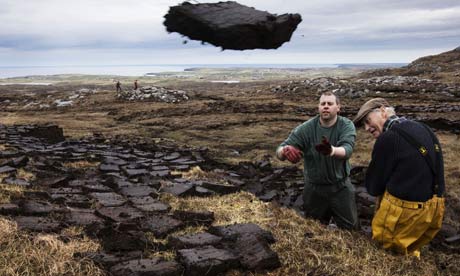
Posted on 05/04/2008 6:08:49 PM PDT by Aristotelian
The soaring price of fuel is leading cash-conscious crofters in the Outer Hebrides to revive the ancient tradition of cutting peat to fire their kitchen stoves and central heating. Over the past few months the steep surge in the price of oil, now routinely used by residents on islands such as Lewis, has led to a rush in orders for traditional, hand-made peat cutters and peat-cutting permits.
Some crofters [tenant farmers] are re-installing peat-burning stoves alongside oil-burning stoves and combi-boilers, or even using them as a replacement heating source.
Calum Macleod, 73, a blacksmith in Stornoway, whose father began making the 12in (30cm) peat cutters by hand in the 1920s, said orders for the tools had risen sixfold over the past few weeks. He has made nearly 40 cutters this year, compared with the six he made last year. Orders are still arriving.
(Excerpt) Read more at guardian.co.uk ...

I see no tree’s good for them
Still a “problem”
“most of the peatlands had won protection under wildlife legislation. And most peat banks available outside the traditionally cut areas were already heavily depleted. “There’s nowhere left, unless we start getting into the designated zones,””
might be some peat pochin going on soon.
I dont see any trees in the picture? The Romans probably burned them all back in the day.
Bogland is windblown and marshy. I don’t think it can support trees, ironically.
As far as I know, the Romans never settled in the Outer Hebrides. I don’t believe they had many trees to begin with.
The Hebrides are a chain of islands off the coast of Scotland, a land to which Hadrian built a wall. The islands were known for the dense, heavy tweeds that were woven by crofters in small cottage (literally) industries. Many years ago, I bought a traditional Harris tweed suit; the fabric was so heavy, I could walk around Chicago, when Januarys were really cold, without a topcoat. It looked very dapper at a Bears game but indoors not so much - it was like being in a sauna.
And wood heat is becoming more popular in the US.
I've still got the thing. I will probably leave it to my grandchildren because it will never wear out.
The Romans never got out that far, nor into the Highlands.
This is why they built Hadrian’s Wall, after all. The Romans viewed the Celts the same way the Chinese viewed the Mongols. Violent raiders best kept on the other side of a wall.

Built by Roman troops, the Wall is estimated to have been between thirteen and fifteen feet high.

The Wall was not designed to prevent movement, but rather to control it, as can be seen in the numerous gateways or milecastles which, as their names suggests, were placed at regular mile intervals along the length of the Wall. Although the Wall had a military function, and enabled watching and patrolling, over time it attracted wider settlement and trade to its forts and garrisons.

The photo above shows a wooden reconstruction of the wall and gatehouse at Vindolanda.

The Praetorium was the official residence of the Roman governors stationed at Vindolanda. Sixteen forts were built on or near the Wall: each was different, with no standard interior plan. Archaeological evidence suggests that the forts were built after the Wall had been laid out and constructed. The forts were designed to house the soldiers that patrolled the Wall, although historians disagree about the numbers who were stationed there.

During the fourth century, the Wall's function as a barrier declined as Roman power waned. Bede writes about the Wall in the seventh century as being eight feet (2.4 m) wide and twelve feet (3.6 m) high. The Wall was undoubtedly a handy source of stone for a number of new buildings, including new monasteries at Jarrow, Monkwearmouth and Lindisfarne.
http://www.bbc.co.uk/history/ancient/romans/hadrian_gallery.shtml
Disclaimer: Opinions posted on Free Republic are those of the individual posters and do not necessarily represent the opinion of Free Republic or its management. All materials posted herein are protected by copyright law and the exemption for fair use of copyrighted works.